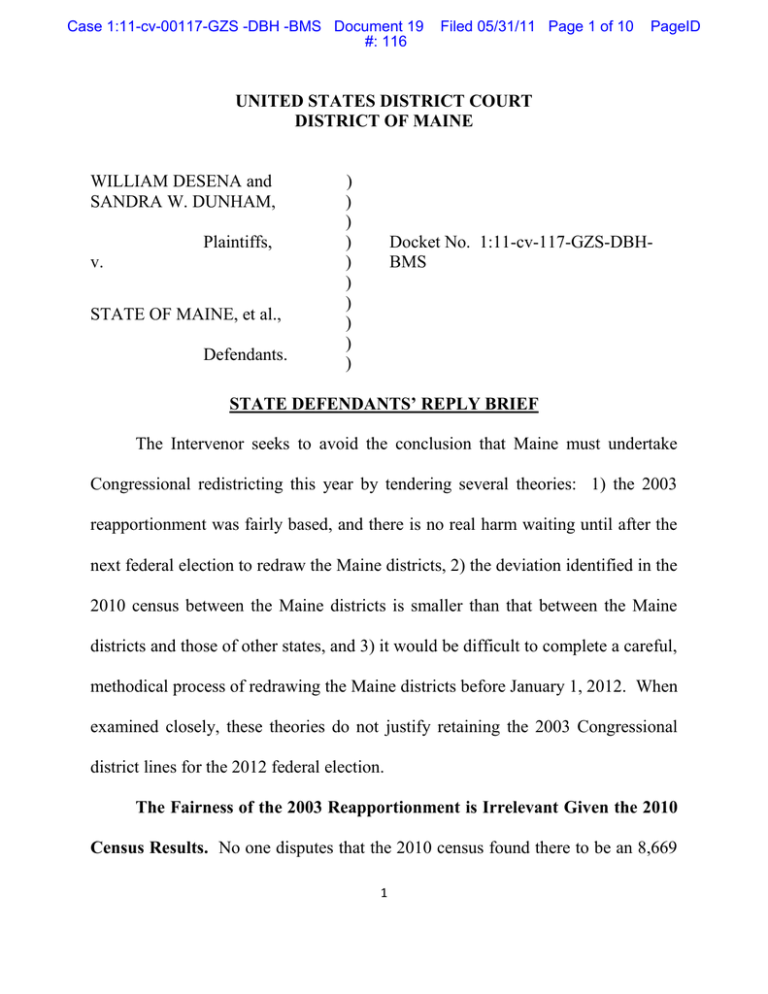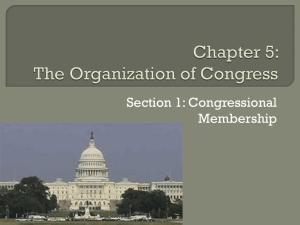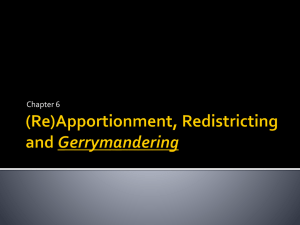UNITED STATES DISTRICT COURT DISTRICT OF MAINE WILLIAM DESENA and
advertisement

Case 1:11-cv-00117-GZS -DBH -BMS Document 19 #: 116 Filed 05/31/11 Page 1 of 10 PageID UNITED STATES DISTRICT COURT DISTRICT OF MAINE WILLIAM DESENA and SANDRA W. DUNHAM, Plaintiffs, v. STATE OF MAINE, et al., Defendants. ) ) ) ) ) ) ) ) ) ) Docket No. 1:11-cv-117-GZS-DBHBMS STATE DEFENDANTS’ REPLY BRIEF The Intervenor seeks to avoid the conclusion that Maine must undertake Congressional redistricting this year by tendering several theories: 1) the 2003 reapportionment was fairly based, and there is no real harm waiting until after the next federal election to redraw the Maine districts, 2) the deviation identified in the 2010 census between the Maine districts is smaller than that between the Maine districts and those of other states, and 3) it would be difficult to complete a careful, methodical process of redrawing the Maine districts before January 1, 2012. When examined closely, these theories do not justify retaining the 2003 Congressional district lines for the 2012 federal election. The Fairness of the 2003 Reapportionment is Irrelevant Given the 2010 Census Results. No one disputes that the 2010 census found there to be an 8,669 1 Case 1:11-cv-00117-GZS -DBH -BMS Document 19 #: 117 Filed 05/31/11 Page 2 of 10 PageID person difference between the two Congressional districts, equivalent to a 0.625 deviation from the ideal. That gap exceeds the deviations that have been rejected by the Supreme Court in reviewing reapportionment plans. Karcher v. Daggett, 462 U.S. 725, 728 (1983) (3,674 people); Kirkpatrick v. Preisler, 394 U.S. 526, 529 n.1 (1969) (0.19 percent from ideal). The fairness of the 2003 reapportionment, resulting in a 23 person difference and a mere 0.001804 deviation from the ideal, therefore, is irrelevant. However fair and appropriate the line drawn in 2003 may have been, the population disparity between the two districts has rendered it no longer in conformity with the standard of equality required by Article I, § 2 under the 2010 census. Intervenor‟s argument (Intervenor Br., 5-12) would allow Congressional district lines drawn under a prior census, which presumably met the constitutional requirements, to be used long after a new census reveals population inequalities. The problem with Intervenor‟s argument is that it asks this Court to freeze old Congressional district lines even though they no longer reflect population variances which “are unavoidable despite a good-faith effort to achieve absolute equality, or for which justification is shown.” Kirkpatrick, 394 U.S. at 531. The harm in using the outdated 2003 line without any effort to conform the districts to the principle of “mathematical equality” is evident: it violates the Constitution. 2 Case 1:11-cv-00117-GZS -DBH -BMS Document 19 #: 118 Filed 05/31/11 Page 3 of 10 PageID Intervenor‟s attempt to find support in League of United Latin American Citizens (LULAC) v. Perry, 548 U.S. 399 (2006) (Intervenor‟s Br. at 8-9), falls short. That case did not involve delaying redistricting, and the procedural history supports the State‟s position in this case. In LULAC, the Texas Legislature failed to reapportion the state‟s Congressional districts following the 2000 census; therefore, a three-judge federal court did so prior to the 2002 federal elections. Id. at 411-12. In other words, reapportionment was conducted, as it should be, in time for the federal elections next following the census. After the 2002 elections, the Republican party gained control of both houses of the Texas Legislature, and thereafter reapportioned the Congressional districts. A variety of groups challenged this plan on the grounds that it was unconstitutional to conduct reapportionment more frequently than once a decade. Id. at 412-13. In rejecting that claim, the Court reemphasized that “the legislative branch plays the primary role in congressional redistricting” and “a lawful, legislatively enacted plan should be preferable to one drawn by the courts.” Id. at 415. 416. Therefore, “if a legislature acts to replace a court-drawn plan with one of its own design, no presumption of impropriety should attach to the legislative decision to act,” and the Court‟s “decisions have assumed that state legislatures are free to replace courtmandated remedial plans by enacting redistricting plans of their own” based upon the same decennial census. Id. at 416. Thus, LULAC does not resolve the issue 3 Case 1:11-cv-00117-GZS -DBH -BMS Document 19 #: 119 Filed 05/31/11 Page 4 of 10 PageID presented here – whether the Congressional districts must be redrawn, at a minimum, prior to the next federal election following receipt of census data showing the existing districts to be malapportioned.1 Intervenor relies heavily upon cases dealing with reapportionment of state legislative districts (Intervenor Br., 16-19), which are not applicable to an analysis under Article I, § 2. As the State defendants previously discussed, the courts allow much greater discretion to states when they reapportion their own districts as compared to their Congressional districts. State Opening Br., 14-16. For example, the Mississippi case discussed by Intervenor recognized that so long as the state legislature redistricts itself at least once every ten years, under unusual circumstances reapportionment may have to wait until after the state elections next following the most recent decennial census. Mississippi State Conference of the NAACP v. Barbour et al., No. 3:11cv159, slip op., 3 (U.S.D.Ct., S.D.Miss., Jackson Div., May 16, 2011). That is not the case here – there are no unusual circumstances preventing the drawing of the single line dividing Maine‟s two Congressional districts prior to January 1, 2012. 1 In a portion of the decision joined in only by Justices Kennedy, Souter and Ginsburg, there was some discussion of the “so-called legal fiction” that the Congressional districts are constitutionally apportioned throughout the decade by population shifts. LULAC, 548 U.S. at 421-22. That fiction mandates neither redistricting throughout the decade nor a prohibition on legislative redistricting mid-decade to replace court-ordered reapportionment. Id. 4 Case 1:11-cv-00117-GZS -DBH -BMS Document 19 #: 120 Filed 05/31/11 Page 5 of 10 PageID The Variance Between Interstate Congressional Districts is Not a Consideration When Reapportioning Intrastate Districts. Two very different analyses are applied to variances between the population size of intrastate as compared to interstate Congressional districts. Regarding intrastate reapportionment of Congressional districts, Article I, § 2 “impos[es] a burden on the States to „make a good-faith effort to achieve precise mathematical equality.‟” U.S. Dep’t of Commerce v. Montana, 503 U.S. 442, 460 (1992) (quoting Kirkpatrick, 394 U.S. at 530-31). This “strictly enforced requirement” can be “applied easily to intrastate districting.” Wisconsin v. New York, 517 U.S. 1, 14 (1996) (emphasis added). The difference between intrastate and interstate apportionment of Congressional districts is “significant.” Id. The goal of precise mathematical equality in the size of Congressional districts is “virtually impossible” to achieve in interstate apportionment because, inter alia, the Constitution guarantees a minimum of one representative for each State. Id. [T]he need to allocate a fixed number of indivisible Representatives among 50 States of varying populations makes it virtually impossible to have the same size district in any pair of States, let alone in all 50. Accordingly, although “common sense” supports a test requiring “a good-faith effort to achieve precise mathematical equality” within each State, the constraints imposed by Article I, § 2, itself make that goal illusory for the Nation as a whole. 5 Case 1:11-cv-00117-GZS -DBH -BMS Document 19 #: 121 Filed 05/31/11 Page 6 of 10 PageID Montana, 503 U.S. at 463 (citation omitted). Congress, therefore, is afforded substantial deference in choosing one of the various mathematical models to apportion the number of Representatives between the states, which inevitably results in wide differences in the population size of districts between the states. Id. at 465-66; see also Wisconsin, 517 U.S. at 19-21; Franklin v. Massachusetts, 505 U.S. 788 (1992). Intervenor‟s argument that the difference in population between the Maine districts under the 2010 census is much less than the difference between the Maine districts and those in other states (Intervenor Br., 12-15), therefore, is irrelevant. The law is quite clear that the constitutionality of differences in population between districts within a state is tested under the “precise mathematical equality” approach, while the population differences between districts in different states is not.2 It Is Not Impossible for the Maine Legislature or the Maine Supreme Judicial Court to Do a Careful Job of Redrawing One District Line Before 2 While the Intervenor accurately notes that the 2010 census data reveals a population differential of 116,278 between Idaho‟s two congressional districts (Intervenor Br., 13), Idaho will form its Commission on Reapportionment on or about June 1, 2011. Idaho Code, 72-1501(b). The Commission‟s final report on reapportioning the state legislative and congressional districts “shall be filed with the office of the secretary of state not more than ninety (90) days after the [C]ommission has been organized,” i.e., on or about September 1, 2011. Id. at 721508. See, http://www.legislature.idaho.gov/redistricting/redistricting.htm. 6 Case 1:11-cv-00117-GZS -DBH -BMS Document 19 #: 122 Filed 05/31/11 Page 7 of 10 PageID January 1, 2012. Intervenor suggests that the Maine Legislature or Supreme Judicial Court are incapable of doing a careful, methodical job of redrawing the line between Maine‟s two Congressional Districts by January 1, 2012. (Intervenor Br., 21-22). This argument must be rejected for several reasons. First, there is nothing in the stipulated record supporting that suggestion. Second, by the time the “liability” aspect of this case is decided, there should be approximately 180 days left before January 1, 2012. The present law affords the Legislature at least 120 days and, if that body is unsuccessful, the Maine Supreme Judicial Court an additional 60 days to redraw the line between Maine‟s two Congressional districts. See State’s Opening Br., 3-7. Intervenor correctly notes that there are many factors that may be considered in redrawing the line between Maine‟s two Congressional districts. See Intervenor Br., 21-22 (referencing need to maintain continuity and communities of interest, reduce travel burdens, and minimize division of political subdivision boundaries). There is no basis to conclude, however, that Maine‟s governmental bodies cannot consider all of those factors and complete a careful job of redrawing this single line to divide the two Congressional districts before January 1, 2012 – the date on which persons seeking 7 Case 1:11-cv-00117-GZS -DBH -BMS Document 19 #: 123 Filed 05/31/11 Page 8 of 10 PageID to run in the primary elections for Congress may begin circulating their nomination petitions.3 CONCLUSION For the reasons discussed, this Court should provide to the Maine Legislature a time frame in which to reapportion Maine‟s Congressional districts, or take on the task should a result not be achieved before the next Congressional election. DATED: May 31, 2011 Respectfully submitted, WILLIAM J. SCHNEIDER Attorney General /s/ Paul Stern PAUL STERN Deputy Attorney General paul.d.stern@maine.gov Tel. (207) 626-8568 PHYLLIS GARDINER Assistant Attorney General phyllis.gardiner@maine.gov Tel. (207) 626-8830 Six State House Station Augusta, Maine 04333-0006 Attorneys for Defendants 3 By comparison, the state that Intervenor puts forward as an example – Idaho – provides 90 days to its Commission to submit a plan to reapportion its two Congressional districts as well as all of its state legislative districts. See n.2, supra. 8 Case 1:11-cv-00117-GZS -DBH -BMS Document 19 #: 124 Filed 05/31/11 Page 9 of 10 PageID CERTIFICATE OF SERVICE I hereby certify that on this, the 31st of May, 2011, I electronically filed the above document with the Clerk of Court using the CM/ECF system, which will send a copy of such to the following registered participants: Timothy C. Woodcock, Esq. EATON PEABODY 80 Exchange Street P.O. Box 1210 Bangor, ME 04402-1210 (207) 947-0111 twoodcock@eatonpeabody.com Janet T. Mills, Esq. Preti Flaherty Beliveau & Pachios, LLP 45 Memorial Circle P.O. Box 1058 Augusta, ME 04332-1058 Tel.: 207-623-5300 jmills@preti.com /s/ Paul Stern PAUL STERN Deputy Attorney General Six State House Station Augusta, Maine 04333-0006 Tel. (207) 626-8568 Fax (207) 287-3145 paul.d.stern@maine.gov 9 Case 1:11-cv-00117-GZS -DBH -BMS Document 19 PageID #: 125 10 Filed 05/31/11 Page 10 of 10





